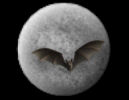|
Actually Leaonard.. you're wrong (again).
The "odds of Intelligent life equation" presupposes that Life is unique and supposes a great many "ODDS" are remote and extreme as factorials in that equation.. .yet these factorials and extreme odds are resolved in each case by mere guess work and from a severe "sampling error" having sampled only *ONE* planet at this point -- The very planet we live on -- Earth. Wait! Such a sampling error should resolve that %100 of the planets out there have intelligent life! True. But burried in this sampling error is the belief that we are rare, unique, and a singular creation of "God" and this taints the sampling error. This is tantamount to stating that the earth is the center of the solar system.
The sole implication of that "equation" is that those who resolved it did so with the belief that "LIFE" elsewhere was a remote possibility and therefore they arrived at this "statistical" result based on their beliefs. However this is only circular logic and as each factorial in this equation is only an enormous GUESS,the error of each guess is only factorialy increased!
------------------------
Analysis based on the recent book entitled “Rare Earth” by two astrobiologists from the University of Washington. The sum total of this equation proves that "garbage in, yields grabage". Needless to say "Astrobiologists" have no "speciment jars" on their desktops and shelves.
We can estimate the number of stars in the galaxy that may have complex life on one of its planets by using a form of an equation called the “Drake” equation:
Ns = Ng * Fsz * Fsm * Fss * Fsf * Fjs * Fjo * Fpo * Fps * Fmo * Fic * Fht * Fat * Foc * Fcb
Where Ns is the number of stars that may have life around them and Ng is the number of stars in the galaxy. Each F terms represents some type of limitation or constraint and stand for the word “Fraction” as in the fraction of the stars or planets with a given criteria. If you multiply all of these fractions together you get the odds of life occurring around any given star. So let’s look at these individually. The numbers are my estimates based on reading about these factors in the book. The authors do not assign numbers.
Ng = the number of stars in our galaxy = about 200 million.
Fsz = the fraction of stars that are of acceptable size. Too small or too big doesn’t work. Most stars are smaller than the sun, the acceptable orbit is closer but causes tidal lock. Big stars emit lethal doses of UV.
Fsz = 1 in 30
Fsm = the fraction of stars that have sufficient heavy metals (therefore so will the planets). Life planets need metals, and thus need solar systems and stars that have condensed from supernova ejecta.
Fsm = 1 in 3
Fss = the fraction of stars that are single (not multiple star systems) with constant output
Fss = 1 in 3
Fsf = the fraction of stars that are far enough away from other dangerous emitting stars. This eliminates much of the center regions of galaxies and dense areas like globular clusters
Fsf = 1 in 30
Fjs = the fraction of stars with a large outer planet such as Jupiter, but not too big or small. Too big will disrupt the other orbits. Not big enough will not sweep up cometary debris that will impact and sterilize earth.
Fjs = 1 in 30
Fjo = the fraction of Jupiter planets that have a circular and not highly elliptical orbit. Many big planets detected so far have eccentric orbits--causing orbital disruption.
Fjo = 1 in 5
Fpo = the fraction of solar systems with a planet in an orbit that has temperatures for water. This range of safe orbits is fairly narrow.
Fpo = 1 in 10
Fps = the fraction of those planets in a water orbit that are near earth size (not big or small). Too small cannot retain an atmosphere. Too big retains a big greenhouse atmosphere.
Fps = 1 in 10
Fmo = the fraction of those planets with a moon our size (important for keeping the earth’s axis of inclination from wandering erratically)—moon’s creation was a “lucky” occurrence in the beginning stages of the earth’s development.
Fmo = 1 in 1000--this one is harder to put a number on, could be bigger
Fic = fraction of those planets with enough of an iron core to generate a magnetic field.
Magnetic field is necessary to block incoming UV rays that are deadly to life.
Fic = 1 in 3
Fht = fraction of those planets with right amount of uranium and potassium to create heat by radioactive decay to generate plate tectonics (which keeps our temperature steady). Plate tectonics is the thermostat that keeps temperatures within a range for liquid water.
Fht = 1 in 3
Fat = fraction of those planets that accrete the right mass of gases to have a suitable atmosphere.
Fat = 1 in 5
Foc = fraction of those planets accrete right amount of water to create a sustainable ocean
Foc = 1 in 10
Fcb = fraction of those planets that accrete enough carbon for life but not too much for a runaway greenhouse
Fcb = 1 in 10
Ftm = fraction of those planets where the timing of development of carbonate-shell producing organisms counteracts the increase in energy over time from the sun
Ftm = 1 in 3
What happens when I multiply all these factors together? I get the odds of one star out of every 2,000,000,000,000,000 having life. Of course my factors estimates may be off somewhat, but there are only 200,000,000 stars in our galaxy. That leaves one planet with complex life for every 10,000,000 galaxies.
|



